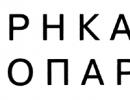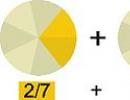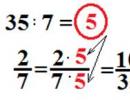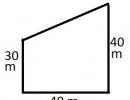Sound-letter (phonetic) analysis of words. Sound-letter analysis of words Vowel sounds in words of the Russian language
Phonetic analysis is a fairly simple and quick process. Despite the ease, thanks to this analysis, the student manages to understand the difference between sound and letter units, and find the differences between spelling and pronunciation. Correctly done phonetic characterization helps the student remember the pronunciation of certain complex words, as well as learn the basic rules of Russian phonetics and orthoepy.
Phonetic transcription
For the word grandfather, the phonetic transcription will look like this: [d’et]. The emphasis will be on the sound unit [e], since this word consists of one syllable.
Characteristics
Phonetic analysis of a word is its division into separate sound units and their characteristics. It is important to describe the sound composition of the word, and not the letter one (letter units do not have such characteristics as sonority, hardness, and the like).
d - [d’] - consonant; soft, steamy; voiced, paired;
e - [e] - vowel, stressed;
d - [t] - consonant, hard, paired; deaf, paired.
Vowels
The letter e can represent:
- [e] in a strong position, i.e. when the emphasis falls on “e”;
- [й'е] after a vowel, soft or hard separator, and also if the letter “e” is the first in the word
- [ie] (read as [i] with an overtone [e]) in a weak position, i.e. when the stress does not fall on “e”.
In the presented word, the sound is in a strong position in the middle of the word, none of the conditions for pronunciation [y'e] are met, which means the letter “e” will be designated as [e].
Consonants
An important difference between consonants is that they have characteristics such as:
- voicedness/voicelessness,
- hardness/softness.
You can indicate whether the sound is paired, i.e. whether it has a pair of loudness/dullness or softness/hardness. This must be indicated after each characteristic or not indicated at all.
Parsing examples
The correct sound-letter analysis of the word “grandfather” will look like this:
Oral analysis
The word grandfather consists of one syllable, which is stressed. The stressed sound is [e]. The word consists of 3 letters that represent 3 sounds: 2 consonants and 1 vowel. Hyphenation of this word is impossible, since it consists of only 1 syllable.
Most games are difficult to clearly subordinate to any one task. They require attention, reflection, application of knowledge, and the ability to draw logical conclusions. Therefore, their distribution into sections is quite arbitrary, but it helps to work on a specific task.
In order to write a word, a child must perform several operations: break the word down into sounds, establish their order, and associate each sound with a letter. To read, on the contrary, match each letter with the sound it represents. In addition, you need to be able to distinguish between vowels and consonants, the hardness and softness of consonants.
Therefore, we start with games that help to master sound-letter analysis, develop phonemic awareness, visual attention and fine motor skills.
Memo for sound-letter analysis
1. We hear and speak sounds, write and read letters. (We talk about sounds, but we denote them in writing accordingly with letters.)
2. There are 33 letters in the Russian language: 10 letters representing vowel sounds (A, O, U, E, Y, I, I, E, E, Yu), 21 letters representing consonants (B, V, D, D, F, 3, J, K, L, M, N, P, R, S, T, F, X, C, Ch, Sh, Shch) and 2 more special letters (or signs) - b and b.
3. Vowel sounds - 6 (A, O, E, I, U, S). There are many more consonant sounds. They are divided into hard and soft. Or, to put it differently, they form pairs based on hardness and softness, for example, [n"] (soft sound) in the word tron and [n] (hard sound) in the word throne. (Please note that, according to tradition, we wrote the sound in square in brackets - [n], and the softness of the sound was indicated by the sign ". But we do not explain these icons to children yet - they will study this at school. Preschoolers, when performing sound-letter analysis, use color: red - to indicate vowel sounds, blue - to indicate hard consonants, green to indicate soft consonants).
4. There are 3 always hard consonant sounds - these are F, W, C and 3 always soft consonant sounds - these are Y, Ch, Shch. All other consonant sounds can be either hard or soft.
5. Vowels I, E, Yo, Yu can denote 1 sound (respectively: i - [a], e - [e], ё - [o], yu - [y]), if they come after consonants (for example: ball - [mach], squirrel - [ b"elka], flax - [l"on], hatch - [l"uk]), and 2 sounds (i - [y"a], e - [y"e], e - [y"o], yu - [y"y]), if they appear at the beginning of a word (yama - [y"ama], raccoon [y"enot], fir tree [y"olka], yula - [y"ula]); after a vowel (bayan - [bai"an], fan - [vei"er], seagulls (from tea) - [tea"ok], bayun (cat-bayun) - [bai"un], and also after Kommersant And b(ate - [sy"el], bunches - [bunch"y", jam - [varen"y"e], linen - [bel"y"o], bindweed - [v"y"unok]).
6. Consonants also differ according to the bone-ringing-voicelessness principle. Always voiced: R, L, M, N, J, always deaf: X, C, Ch, Shch. The remaining consonants form pairs: B - P, V - F, G - K, D - T, F - W, 3 - C.
7. Words are divided into syllables: the number of vowels in a word, the number of syllables.
Wave
Draw a wavy line so that the vowels remain at the top and the consonants at the bottom.
Download the pictures to your computer and print them for your child.
What more?
What are more - vowels or consonants? Complete the letters so that there are equal numbers of vowels and consonants in each line.

Find the letters
Underline the letters you need to form words: house, bow.

Sound-letter analysis of words at school
Phonetics- a branch of the science of language that studies speech sounds. Phone (Greek) - sound.
Graphic arts- a branch of the science of language that studies letters. Grapho (Greek) - writing.
Letters- signs indicating speech sounds, we see and write them. The Russian language has 33 letters representing sounds. Graphic characters also include an accent mark, a hyphen (dash), punctuation marks and others, but the letters ь and ъ do not indicate sounds. Sounds are formed in the speech apparatus when air is exhaled. When consonant sounds are formed, the exhaled air encounters various obstacles in the mouth (lips, teeth, tongue, palate). A stream of air overcomes obstacles and this produces consonant sounds. Consonants in the Russian language are divided into voiced and voiceless, hard and soft. Hard consonant sounds have softness pairs [b] - [b"], [v] - [v"], [g] - [g"]. They do not have softness pairs [zh], [sh], [ts] , they are always hard.
They do not have a pair in hardness [h"], [sch"], [th"], they are always soft.
Note. The sound denoted by the letter ш is a long, soft, dull sound, for example: cheeks, brush. Paired with the long soft voiced one is [zh "zh"], which is found in a few words, for example: yeast, reins.
Consonant sounds are divided into voiced and voiceless. When voiced consonants are formed, the vocal cords vibrate and a voice is formed. And when pronouncing voiceless consonants, the vocal folds do not vibrate, and noise is formed. The vibration of the vocal cords can be felt by placing the back of your hand against your throat. They have a pair of voicedness and deafness [b]- [p], [v]- [f], [g]- [k], [d]- [t], [zh]- [sh], [z]- [With]. They do not have a pair for deafness [th], [l], [m], [n], [r], they are always voiced. They do not have a voiced pair [x], [ts], [ch], [sch], they are always deaf.
Voiced and voiceless consonant sounds can differentiate words. For example: house - volume, count - goal, ball - heat, etc. Paired soft and hard consonant sounds distinguish words, for example: bow - hatch, small - crushed, nose - carried, horse - horse. A voiced consonant at the end of a word and before a voiceless consonant is replaced by a paired voiceless one. This replacement is called stunning. For example: tooth - tooth, low - low. A voiceless consonant before a voiced consonant (except for l, p, m, n, th) is replaced by its paired voiced consonant. This replacement is called voicing a consonant. For example: request - ask, hand over.
Examples of sound-letter analysis of words
Watchmen - [starazhyt] - 9 letters, 8 sounds, 3 syllables.
S - [s] - consonant, voiceless, paired, hard, paired;
T - [t] - consonant, voiceless, paired, hard, paired;
R - [p] - consonant, voiced, unpaired, hard, paired, sonorous;
O - [a] - vowel, unstressed;
Ж - [ж] - consonant, voiced, paired, hard, unpaired;
And - [s] - vowel, stressed;
T - [t"] - consonant, deaf, paired, soft, paired;
b - [-]
Volume "m - [aby"om] - 5 letters, 5 sounds, 2 syllables.
O - [a] - vowel, unstressed;
B - [b] - consonant, voiced, paired, solid, paired;
b - [-]
E - [th"] - consonant, voiced, unpaired, soft, unpaired, sonorous;
[o] - vowel, stressed;
M - [m] - consonant, voiced, unpaired, hard, paired, sonorous.
A phonetic analysis of the word “five” will give a clear idea of both the nature of each component and the possible difficulties that arise in writing. It is necessary to carry out a sound-letter analysis of this word.
Phonetic analysis
It is required to determine the number of sounds and letters in the lexeme:
- The subject of the study consists of one syllable: five.
- The numeral has four letters, and the number of sounds is one less.
- The subject of the study has a single syllable - stressed: five.
- It is impossible to transfer the parsed numeral.
Transcription of the word
A competent transcription looks like: [p’at’]. The discrepancy between the transcription and the written form is obvious.
Sound-letter analysis
The previously established information about how many sounds and letters in the word “five” showed the placement of stress. Now it becomes necessary to analyze the components:
- p – [p’] - is classified as a consonant; is deaf, having a pair; has a soft stance;
- i – [a] - refers to vowels; has an accent;
- t – [t’] - is classified as a consonant; is deaf, having a pair; has a soft stance;
- b - has no sound.
Despite the fact that transcription differs from the written form of the numeral being parsed, there are no difficulties in writing it.
To perform this analysis of a word as a sounding unit of language, a transcription is written - a record of the sound composition of the word. An exact recording is made of how the word sounds.
Often the spelling of a word and its sound do not match. A word can have the same number of sounds, more sounds than letters, and more letters than sounds.
Sound-letter analysis is an analysis of the sound composition of a word and its letter representation in writing.
First, let's figure out what sounds are.
All sounds are divided into vowels and consonants.
Letters that represent vowel sounds are considered vowels,
Letters representing consonants - consonant letters.
Consonants
Consonants- these are sounds, during the pronunciation of which a stream of air passing through the oral cavity encounters various obstacles.
Let us list the consonant sounds and the corresponding consonant letters.
B C D D F G H J K L M N P R S T F X C Ch Sh Sh
Many consonant sounds form pairs and are called paired.
There are couples voiced – voiceless:
There are hard and soft pairs:
| Solid | B | IN | G | D | Z | TO | L | M | N | P | R | WITH | T | F | X |
| Soft | B" | IN" | G" | D" | Z" | TO" | L" | M" | N" | P" | R" | WITH" | T" | F" | X" |
| Unpaired solids | AND | Sh | C | ||||||||||||
| Unpaired soft | H | SCH | Y | ||||||||||||
Vowel sounds
Vowel sounds- these are sounds, during the pronunciation of which the stream of air passing through the oral cavity does not encounter obstacles; they can be sung.
There are six vowel sounds corresponding to six vowel letters:
A O U Y E I
In syllables, the sounds A, O, U, Y, E provide firm pronunciation of the consonant letters in front: M A, M O, M U, M Y, M E.
The sound I provides a soft pronunciation - M I.
The remaining vowels have two sounds:
E [ye] Yo [yo] Yu [yu] I [ya]
In syllables, these sounds provide soft pronunciation: D E, D Yo, D Yu, D Ya.
Vowel sounds are divided into drums And unstressed.
The sound that is stressed in a word is called percussion, if there is no stress on a sound, then it is called unstressed.
!!! We remember: the number of vowels in a word, the number of syllables.
How to make a sound-letter analysis of a word.
The child must write the word and put the accent mark.
The number of vowels and consonants in a word is indicated.
All letters of the word are written in a column. The sound is indicated next to each letter in square brackets. If a letter represents two sounds, both sounds are written down. If a letter does not make a sound (ъ or ь sign), nothing is written next to it.
Then, for vowel sounds, “vowel” is written and whether it is stressed or unstressed is determined.
For consonant sounds, “consonant” is written, then hard or soft, paired or unpaired in softness, voiced or voiceless, paired or unpaired in voicing is determined.
Determines how many syllables there are in a word.






